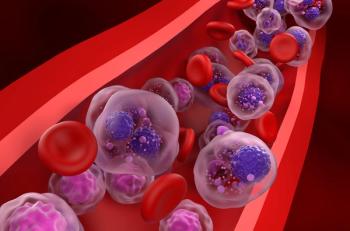
Plozasiran Shows Promise as Cholesterol-Lowering Treatment for Mixed Hyperlipidemia
Key Takeaways
- Plozasiran, an APOC3-targeted RNA, shows efficacy in reducing triglycerides and non-HDL cholesterol in mixed hyperlipidemia, addressing residual ASCVD risk.
- Clinical trials MUIR, SHASTA-2, and PALISADE demonstrate plozasiran's effectiveness in lowering triglycerides and remnant cholesterol, with improved glycemic control.
Plozasiran shows promise in reducing cholesterol and triglyceride levels in patients with mixed hyperlipidemia and other harmful conditions, addressing significant cardiovascular risks.
Patients with mixed hyperlipidemia are often prescribed statins to help lower their cholesterol. Statins help decrease levels of low-density lipoprotein cholesterol (LDL-C) circulating in the blood and constitute a safe and effective treatment option for these patients. However, many patients face barriers to statin use, including preconditions that prevent them from taking a statin or requiring another medication that has contraindications with statins. In addition, there is a substantial residual risk of atherosclerotic cardiovascular disease (ASCVD) that remains attributed to elevated non-high-density lipoprotein (non-HDL) by remnant cholesterol in triglyceride-rich proteins.1-3
With these factors in consideration and the ever-present need to develop more effective novel therapies for the conditions that are most prevalent in communities, research into new medications for the treatment of patients with mixed hyperlipidemia has remained ongoing. Recently, plozasiran (Arrowhead Pharmaceuticals), an investigational hepatocyte-targeted APOC3 small interfering RNA, has shown promise in clinical trials as a possible treatment for patients with mixed hyperlipidemia who harbor a residual risk of atherosclerotic cardiovascular disease.1,4
Clinical Trials Demonstrate Effectiveness of Plozasiran
In the double-blind, placebo-controlled phase 2 MUIR trial (NCT04998201), plozasiran
Plozasiran was also evaluated in the phase 2 SHASTA-2 trial in patients with severe hypertriglyceridemia (SHTG), a condition for which the effectiveness of plozasiran is critical to evaluate in relation to its potential in mixed hyperlipidemia. Published by investigators in JAMA Cardiology, plozasiran demonstrated significant dose-dependent, placebo-adjusted reductions in triglyceride levels, driven by reductions of APOC3. Critically, plozasiran was associated with dose-dependent increases in LDL-C but was also found to not alter apolipoprotein B and significantly decrease non-HDL cholesterol levels. Remnant cholesterol was also found to be durably reduced in patients treated with plozasiran.5
Furthermore, in the phase 3 PALISADE trial, which investigated plozasiran in patients with familial chylomicronemia syndrome (FCS)—a rare genetic disorder characterized by severely high triglyceride levels in the blood that can cause acute pancreatitis if left untreated—the treatment induced sustained reductions in apolipoprotein C-III and triglycerides. Importantly, total cholesterol, non-HDL-C, and very low LDL-C were all found to be meaningfully reduced with plozasiran treatment in the PALISADE study. Together, the results of these 3 clinical trials provide a solid foundation of data, demonstrating plozasiran’s effectiveness at reducing harmful fats in the blood.6
Future Research Directions for Plozasiran
Based on the positive results from the MUIR, PALISADE, SHASTA-2 trials, Arrowhead Pharmaceuticals has announced its intention to advance plozasiran into a phase 3 cardiovascular outcomes clinical trial called CAPITAN, which will enroll patients with mixed hyperlipidemia and a residual risk of ASCVD. Investigators believe that plozasiran can address significant unmet needs in patients burdened with high cholesterol, and if data continues to be positive, plozasiran could become an effective novel treatment to lower cholesterol in adults.1
“We see plozasiran clinical data as strong and consistent across multiple studies in patients with FCS, SHTG, and mixed hyperlipidemia, and believe plozasiran has the potential to address significant unmet needs in all 3 patient populations,” Bruce Given, MD, chief medical scientist at Arrowhead Pharmaceuticals, said in the news release.1
Pharmacists should continue to evaluate plozasiran as it proceeds through clinical development and be prepared to counsel patients regarding its use if the treatment eventually receives full regulatory approval.
REFERENCES
1. Arrowhead Pharmaceuticals. Arrowhead Pharmaceuticals to advance RNAi-based plozasiran into phase 3 CAPITAN cardiovascular outcomes trial. News Release. Releaased June 25, 2024. Accessed May 9, 2025. https://ir.arrowheadpharma.com/news-releases/news-release-details/arrowhead-pharmaceuticals-advance-rnai-based-plozasiran-phase-3
2. Cleveland Clinic. Hyperlipidemia. Last Reviewed August 4, 2022. Accessed Online May 9, 2025. https://my.clevelandclinic.org/health/diseases/21656-hyperlipidemia#management-and-treatment
3. Mayo Clinic Staff. Statin side effects: Weigh the benefits and risks. Mayo Clinic. Last Updated March 11, 2025. Accessed May 9, 2025. https://www.mayoclinic.org/diseases-conditions/high-blood-cholesterol/in-depth/statin-side-effects/art-20046013
4. Gerlach A. Plozasiran may help reduce cholesterol levels in patients with mixed hyperlipidemia. Pharmacy Times. Published October 4, 2024. Accessed May 9, 2025. https://www.pharmacytimes.com/view/plozasiran-may-help-reduce-cholesterol-levels-in-patients-with-mixed-hyperlipidemia
5. Gallagher A. Arrowhead Pharmaceuticals submits FDA application for plozasiran in familial chylomicronemia syndrome. Pharmacy Times. Published November 22, 2024. Accessed May 9, 2025. https://www.pharmacytimes.com/view/arrowhead-pharmaceuticals-submits-fda-application-for-plozasiran-in-familial-chylomicronemia-syndrome
6. Gaudet D, Pall D, Watts GF, et al. Plozasiran (ARO-APOC3) for evere hypertriglyceridemia: The SHASTA-2 randomized clinical trial. JAMA Cardiol. 2024;9(7):620-630. doi:10.1001/jamacardio.2024.0959
Newsletter
Stay informed on drug updates, treatment guidelines, and pharmacy practice trends—subscribe to Pharmacy Times for weekly clinical insights.






































































































































































































